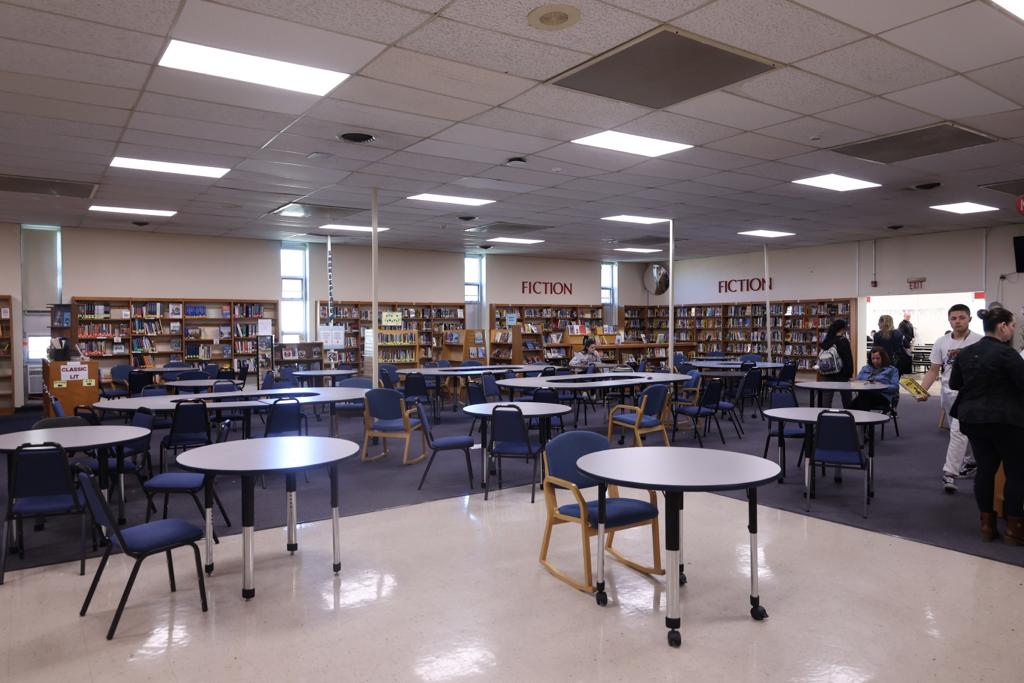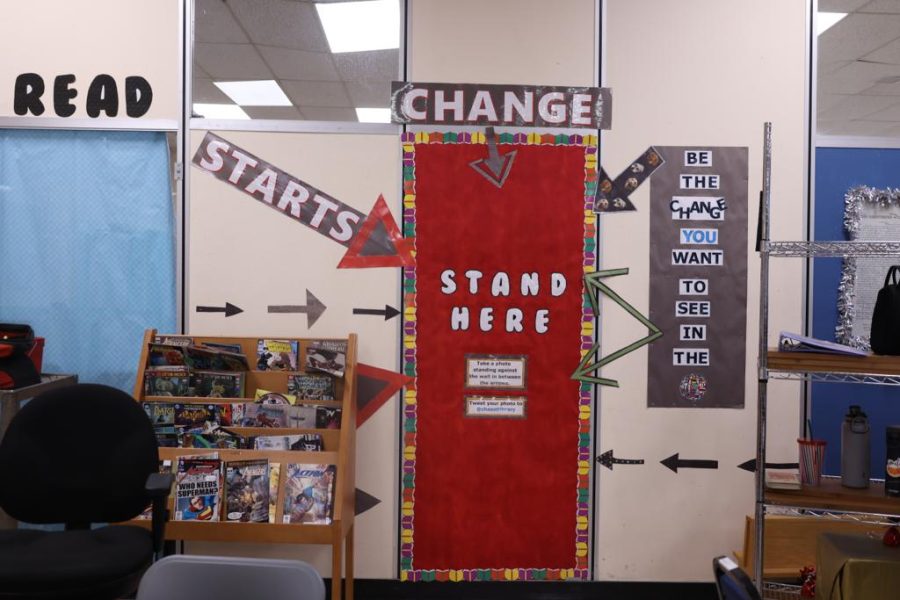In today’s digital world, where do libraries fit in?
May 16, 2023
Across the country, libraries are struggling.
Since 2019, 38% of school librarians nationally have reported that their budgets were cut. Within the past decade, the number of librarians themselves has decreased by 20% in schools across the U.S. Public libraries aren’t thriving, either: they have faced millions of dollars in budget cuts over the past several years. Could one of society’s most cherished institutions be headed towards extinction?
Not if educators in Cherry Hill’s public schools have anything to say about it.
“I believe that libraries are an essential part of any school,” said Dr. Joseph Meloche, Superintendent of the Cherry Hill Public School District. In 2019, Meloche was named “Outstanding Administrator of the Year” by the New Jersey Association of School Libraries for his support of library/media centers in the district.
In the words of Abbey Greenblatt, who retired this year after 14 years as a Media Specialist at East, “One of the best things about this district is that they believe in the libraries.”
A storied past defines East’s library
Libraries have not always looked quite like they do today.
“The annex was completely filled with microfilm,” described Greenblatt. “Long before my time.”
Years ago, the library annex, a large, high-ceilinged space connected to the library’s classic carpeted book room, looked very different than it does now. The space had an upper floor, where many books were housed. It had shelves lining its walls. And, yes, it was once full of microfilm, allowing students to view old newspaper clippings and documents through now-antiquated but then-brilliant technology.
Cherry Hill High School East was founded in 1966, 17 years before the internet would be invented. Encyclopedias — tangible, printed ones, from an era when flipping through a giant book was the closest thing to clicking through a Wiki — were all the rage. Stacks of these large references filled the East library, with new copies purchased often to keep information up-to-date. Old books, with information that was no longer accurate, would have to be discarded.
The labor-intensive nature of maintaining such a collection is reflected in additional elements of the library’s history. Greenblatt described a “long line of librarians” who helped shape the space in years past; East archives reflected an even longer line than one might expect. In 1984, East had not one or two librarians, as is common today, but eight. The team of men and women who did so were referred to as Media Operators, according to Ms. Janet Cohen, a longtime Cherry Hill Public Schools Administrative Assistant. The yearbook from that year described the Operators as “provid[ing] not only books, magazines and newspapers but also TV sets, recorders, video machines and micro-film and micro-fiche.”
*Graphic by Aiden Rood, Eastside Editor-in-Chief
From dozens of unique individuals to endless materials new and old, the library at East is something of a time capsule. Inside, one can observe a microcosm of the changing ways educators have worked to disseminate information over the years.
Today’s library reflects digital evolutions
In an evolving world, libraries have taken on many new forms to serve modern student needs. While even more change is coming, the current state of libraries at schools like East offers a window into how learning takes place in a digital age.
In years past, one’s expectation that books would be the first thing one encounters when walking into a school library would be accurate. That is not the case today. Now, two large wooden shelves bearing laminated “Classic Lit” signs and holding titles like “Beowulf” and “The Complete Poetical Works of Shelley” can be seen — but only after traversing past or looking between two much different large objects, in this case iMac computers on rolling desks. The gleaming silver chrome that has become a signature of Apple products has come to be a signature of some libraries, too. The books are still here, of course; but in an apt metaphor, they are no longer quite the centerpiece of this space.
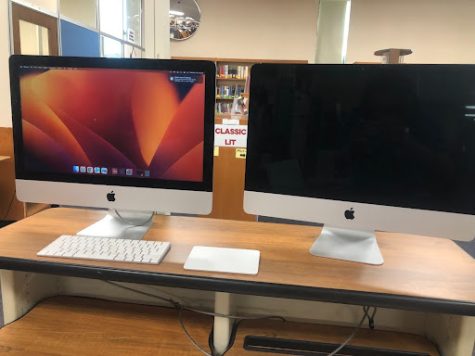
Students visit the library at East for all kinds of reasons. Its computer lab houses the school’s eSports team. The annex transforms into a cafeteria at 10:30 a.m. each day. Students come down for English classes, research projects, or just for fun. Perhaps most prominently, they come here to print.
Since 2019, when the library purchased a new printer for the annex, 1,319,550 sheets of paper have come out of the machine. This number is likely skewed downwards because large numbers of students were absent for many months of the printer’s presence, which largely overlapped with the COVID-19 pandemic. Cindy O’Reilly, the sole librarian currently serving East students after Greenblatt’s retirement, estimated that one fourth of the sheets printed were ordered by teachers. That leaves hundreds of thousands of sheets being printed by students every year.
While some traditionalists may view the increasing usage of libraries as technology hubs as a negative, Greenblatt and O’Reilly shared a different perspective.
“My hope is that bringing that technology piece along with the resource piece will help to cement us in the building,” said O’Reilly.
More and more, librarians are looking at technology as an anchor that can secure their status as necessary and useful parts of the modern school environment. The terminology “media center,” which is the official name of the library at East and many other schools, is one example of how librarians are using technology’s appeal in this way.
“Anything you can [do to] get people to walk through the door is going to help,” O’Reilly added.
By offering the appeal and convenience of technology, the media center can draw students in. They’ll come down to print a homework assignment or check out a Chromebook. On some special occasions, they might even be connected with the library’s virtual/augmented reality tools by their teachers. Then, O’Reilly and others hope, they’ll stay for a while, and maybe even check out a book.
Greenblatt estimated that before the pandemic, circulation might have included around 400 books being checked out by about 160 students in a school year. While COVID-19 affected circulation significantly and made it difficult to analyze clear trends and statistics about check-outs, one thing is clear: in today’s library, and even before COVID, relatively few students — likely less than 10% of the student body — are ever checking out a physical book.
“We have gone digital… we have the eBooks and the databases,” Greenblatt said, explaining how circulation has shifted from print copies to more online resources.
The library maintains access to more than 50 online databases and collections for student research. Ranging from coverage of global business issues to information on over 2,000,000 plant specimens, the resources are nearly endless. They offer students strong capabilities to find primary sources that go deeper than anything a Wikipedia article or even a single book could provide. Meanwhile, a growing collection of eBooks empowers students to read innumerable works of fiction and nonfiction on their electronic devices.
Nevertheless, the library’s print collection is far from gone. The East library owns approximately 20,000 books, and it continues to add around 200 selections every year. Currently, the new print additions are most often in categories such as popular fiction or graphic novels.
Some might ask why resources continue to be devoted to a print collection that seldom sees usage that reflects its full potential. Should 200 new books be bought in a year when relatively few — around 400 out of 20,000, pre-pandemic — of the existing books were checked out?
Staff and administrators in the Cherry Hill Public Schools appear to remain steadfast in their support of such investments. O’Reilly said that she hopes to increasingly incorporate students into the library’s book purchasing process in order to increase circulation and interest in the new books added to the library each year. She said that in future years, she may conduct surveys of middle school students to find out what genres and book series they are interested in; then, when those students reach high school, the previous few years’ book purchases would better reflect their interests. Such purchases would help get physical books in the hands of new students more often.
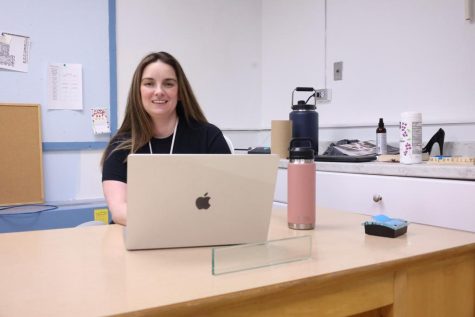
“I prefer to read something that’s in my hands,” said Dr. Joseph Meloche, expressing a sentiment that has helped libraries and bookstores persist in the digital age. “I like the physical experience that comes along with holding a book.”
Nonetheless, the library is on a path that, while maintaining traditional print expansions, meets students’ digital needs more than ever. This reality is reflected in the current budget of East’s media center, which looks significantly different than it would have before computers and printers were the central elements of a school library. Costs for digital media licensing — including databases, eBooks, and other digital resources — total approximately $30,000 per year at East, according to Mr. Lou Papa, an assistant principal at East who supervises the media center. He said that hard materials cost less than half of that, coming in at around $14,000 in a year. While Papa echoed the sentiment that physical materials will always be necessary in the school library, it is clear that the monetary trends are shifting towards a digital-first approach. Papa foresaw that funds could continue to shift, suggesting that the money freed by the decreasing costs of hard copies — if librarians choose to shift some funds towards other priorities — could eventually be spent elsewhere.
Libraries look very different today than they did 10, 20, and 30 years ago. In the next few decades, they are sure to evolve further. Advocates who hope to see libraries maintained in their current form may be discontented. However, for those who hope simply to see libraries stay afloat amidst national cuts and changing priorities — for those who hope to save libraries from their struggles, and possibly from extinction — the future could be promising.
Change is on the horizon
Should the library have a coffee bar?
“If I had it my way, we’d have Starbucks,” O’Reilly said when asked about the idea, which was initially proposed and supported by Papa. “But I don’t know.”
It’s a bold idea. Its likelihood of actual implementation may be rather low. But, nonetheless, the mere possibility is a symbol of the innovative direction in which the media center is moving. Papa, O’Reilly and others hope to create a comfortable, relaxed space that will span the library and annex and become a gathering space for students.
According to Dr. Dennis Perry, East’s principal, coffee is a drink for adults, which may make its offering at East less probable. Instead, the media center might move in the opposite direction of adult offerings: it may evolve to become more like the libraries found in middle schools.
“I think of libraries almost like a sacred space,” said Skye Silverstein, the library media specialist at Cherry Hill’s Rosa International Middle School.
Silverstein said that she has worked to cultivate a community space in her school library. The centerpiece, she emphasized, remains books: Rosa’s library has over 15,000 of them. Like East’s library, Rosa’s has thousands of eBooks and databases. But where the two libraries diverge — and where there are opportunities for East to learn from Rosa — is in the space itself.
“In our library, we got a grant a couple years ago to create a mindfulness area, so we have plants and a water fountain,” Silverstein said. “It’s an area where people can relax in cozy chairs… They can either read, sit quietly or connect with some friends there. It doesn’t have to be silent all the time.”
Rosa’s library also features a “Maker Space” — a room full of LEGO bricks, building blocks, and other creative tools for students to use. Silverstein said she sees the space as one in which students can take a break from technology and work with their hands. Alongside the mindfulness space, some digital resources and, of course, a collection of books, the Maker Space is part of a library that Silverstein described as “flexible.”
“It responds to the needs of its community,” she said, offering the mindfulness space as an example because it “came out of the social emotional needs that were really exacerbated by the pandemic.”
The library’s flexibility can sometimes be literal: its furniture can move around and the space can adapt to play host to events of all kinds. Events early this year included an archaeology workshop and a Q&A with a children’s book author. The library has space suited to serve teachers and their classes for studying, too. This kind of library really has it all.
Back at East, O’Reilly has high hopes to create a space that, similarly, will have everything students need to succeed. This year, she began waiting to receive funds that have been allocated for East’s library as part of a 2022 bond referendum in which voters approved spending $363,000,000 on improvements to the district’s schools. For decades, Cherry Hill schools were underfunded by the state of New Jersey, leading to outdated and crumbling infrastructure in some schools. Now, with millions of dollars flowing in to improve the school buildings, East’s library is ready for an upgrade.
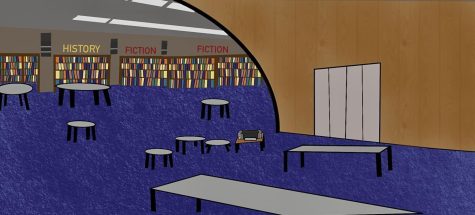
“I hope that we can make better use of [the space] for the sake of our kids and mold it into what our students need,” O’Reilly said.
Together with Greenblatt, Papa, Perry and other stakeholders, O’Reilly is working to develop a new vision for the school library at East. Once funding comes in and an architect is assigned to projects at East, she will work with the architect to formalize plans and execute her vision for the space.
O’Reilly recalled that when Rosa’s library was built, multiple companies that specialize in library design were involved and laid out proposals for the space. She hopes to similarly bring in experts who can make proposals regarding furniture, technology, and other features.
“A student union opportunity, that’s the hope,” Perry said when asked about plans for the library space and their resemblance to student unions commonly found in college settings.
According to Perry, the annex’s current, 2022-2023 setup is a result of the COVID-19 pandemic. Pandemic restrictions necessitated the creation of additional space for students to eat lunch, leading to the annex housing lunch tables as the majority of its furniture and transforming into somewhat of a de facto cafeteria.
Now, a new transformation can occur: Perry envisions new, flexible furniture and seamless integration of technology in the library and annex. The annex, with its large size and open floor plan, could serve as an effective space for hosting meetings. Perry is working with technology experts in the district to organize the installation of technological tools that could include large-screen televisions, a microphone and speaker system, and any other items needed to facilitate meeting elements like presentations and Q&As.
In addition to the plans for internal transformation, the annex is undergoing external changes in order to better integrate it with the original library space. Years ago, a wall was put up between the two spaces. As part of the new improvements to the library, O’Reilly planned to take it down and open up the connection between the library and its annex. Ultimately, the wall’s removal did not have to wait for the coming changes — instead, it was removed after it was determined to create an egress violation, O’Reilly said. Thus, in an unexpected way, the library’s transformation has already begun.
From ergonomic furniture to state-of-the-art technology, the future is coming quickly in East’s library. The upcoming changes reflect how some schools are working to adapt, not cut, libraries’ place in the modern educational landscape.
What will fill the shelves?
As school libraries evolve to survive in the digital age, one major question remains for their future: how central of a role will books continue to play? Will they get the current, $14,000 per year treatment? Will they become a smaller piece of the puzzle? Or will other forms of “media” come to dominate libraries and media centers entirely?
Silverstein and other pre-high school librarians are working to ensure that books remain at the center of libraries’ work and purpose, along with new additions like digital resources. One such librarian is Kim Laskey, who works at Cherry Hill’s Joseph D. Sharp Elementary School and said she was “cautiously optimistic” about libraries’ role in the future of education.
“At the elementary school, they still get excited about a book,” Laskey said.
Books and other physical resources still do not dominate the budgets at schools like Sharp. Digital resources cost roughly $7,000 out of a $10,000 overall budget per year; hard materials round out the remaining spending in Laskey’s budget, which she said has slightly decreased from past years. But, as far as the kids are concerned, books remain a big deal at the elementary level.
Laskey described kids approaching her on the way to their school buses and telling her about their love for a book her library had lent them. Such lending occurs often and in great numbers: Laskey estimated that the Sharp library’s circulation is around 400 books per week.
It’s not just book check-outs that remain alive and well with younger kids, either. Library skills, such as analyzing maps and using the Dewey Decimal System, remain priorities for elementary educators.
“Those are very important and there’s no other place to get those kinds of skills,” Laskey said.
The priorities look different, however, at the high school level. There, a stark contrast exists in terms of both circulation and education. High school students might check out 400 books in an entire school year at East, while their younger siblings churn through that amount in one week. Meanwhile, they might receive a lesson from the media center on virtual reality or digital presentation tools, while elementary students grasp the basics of library usage. Such differences reflect the various needs and focuses of students in different age groups.
“I think there’s a difference with how children, how students, the people of your generation, are coming up in terms of how they’re accessing information,” Meloche said.
Within the educational differences at various levels lie some major questions: where do libraries go from here? What will fill their shelves when there are such wide varieties of student needs, experiences, and desires regarding the library? Will elementary and high school libraries become totally different-looking entities? Where does that leave public libraries, then?
If any answers to these complex questions exist, they might be rooted in compromises.
“I will tell you my honest feeling is I’m not as concerned with what kids read or what people read, as long as they are reading,” Meloche said.
He, along with other educators, sees a future in which kids are still reading, of course — just maybe not in the same way they used to. Reading articles online, engaging with digital encyclopedias, and also returning to old-fashioned books at times could all blend together to create the future to which libraries will have to adapt.
In such a future, libraries can maintain a vital role. More than ever, the information students consume is subject to controversies and contradictions that increase complexity. From decoding misinformation to dodging unreliable sources, a new set of library skills — one that is more about analyzing information, rather than simply finding it among the shelves — could emerge.
Those shelves might be full of books. They might be focused on accessing resources digitally. They might evolve to contain something else entirely. But here in Cherry Hill — and, if many educators have their way, in schools and communities everywhere — libraries will persist. They will overcome their struggles and they will provide vital resources to the people they serve.
“The library is often the beating heart of the school, the center in so many ways: academically, in terms of thinking, in terms of learning. It’s a place where children have the opportunity to truly be free and to be themselves, to explore information, to look up new things, to try new things, to find out how to access material and how to discern whether material is accurate or beneficial or valuable. I think the libraries are just a very special place,” said Meloche.
With the backing of administrators, the support of educators, and the adaptability of their caretakers, these “very special places,” as Meloche described them, seem poised to overcome their struggles, at least for now. But, in the long-term, will libraries remain special enough to maintain their place in an ever-evolving world?
Only time will tell.
This article, a piece of long-form journalism, was produced over the course of several months as part of Aiden Rood’s independent study project, titled “American High School,” which aimed to analyze national issues in education through the lens of those issues’ role at Cherry Hill High School East, a large, suburban high school in Cherry Hill, New Jersey.
Enis Ercan (‘24) contributed digital support for this project.
